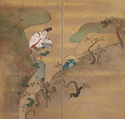Returned to lender The Met accepts temporary loans of art both for short-term exhibitions and for long-term display in its galleries.
The Ivy Way Through Mt. Utsu (Utsu no hosomichi)
Sakai Hōitsu Japanese
Not on view
This famous scene occurs in chapter nine of the classic mid-tenth-century narrative The Ise Stories (Ise monogatari). While traveling eastward from Kyoto, the protagonist of the tale—identified as the courtier-poet Ariwara no Narihira—arrived at a narrow, forbidding path crossing Mt. Utsu, and there by chance met a monk who was heading back to the capital. Having met the monk once before, Narihira begged him to carry a message to his wife, whom he had to leave behind. Seated with his back to us, wearing a traveling hat and blue robe, the monk waits while Narihira, dressed in a white robe, writes the following poem to his beloved wife:
Suruga naru
utsu no yamabe no
utsutsu ni mo
yume ni mo hito ni
awanu nari keri
Amid the sad hills
of Mount Utsu
in Suruga province,
I can no longer see my lover,
not even in my dreams.
—Trans. John T. Carpenter
Here, the courtly world of the ancient narrative is conjured by the hills that span laterally the almost square picture plane and by the trees and rocks rendered in the tarashikomi (“dripping in,” or mottled pigmentation) technique. Pressing in from either side, the hills create the feeling of a narrow path deep in the mountains.
Due to rights restrictions, this image cannot be enlarged, viewed at full screen, or downloaded.
This artwork is meant to be viewed from right to left. Scroll left to view more.



